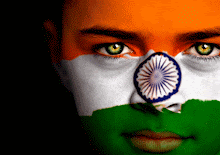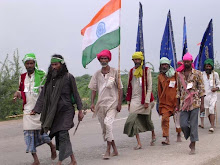
Naxalite or Naxalism is an informal name given to communist groups that were born out of the Sino-Soviet split in the communist movement in India. Ideologically they belong to various trends of Maoism. Initially the movement had its centre in West Bengal. In recent years, they have spread into less developed areas of rural central and eastern India, such as Chhattisgarh and Andhra Pradesh through the activities of underground groups like the Communist Party of India (Maoist) They are conducting an insurgency, typically called the Naxalite-Maoist insurgency. They now have a presence in 40 percent of India's geographical area, and are especially concentrated in an area known as the "Naxal Belt," comprising 92,000 square kilometers. According to India's intelligence agency, the Research and Analysis Wing, 20,000 insurgents are currently in operation, and their growing influence prompted Indian Prime Minister Manmohan Singh to declare them as the most serious threat to India's national security.
The CPI (Maoist) and some other Naxal factions are now considered terrorists by the Government of India. In February 2009, Central government announced its plans for simultaneous, co-ordinated counter-operations in all Left-wing extremism-hit states—Chhattisgarh, Orissa, Andhra Pradesh, Maharashtra, Jharkhand, Bihar, Uttar Pradesh, and West Bengal, to plug all possible escape routes of Naxalites.
The CPI (Maoist) and some other Naxal factions are now considered terrorists by the Government of India. In February 2009, Central government announced its plans for simultaneous, co-ordinated counter-operations in all Left-wing extremism-hit states—Chhattisgarh, Orissa, Andhra Pradesh, Maharashtra, Jharkhand, Bihar, Uttar Pradesh, and West Bengal, to plug all possible escape routes of Naxalites.
History of Naxalite.
The term Naxalites comes from Naxalbari, a small village in West Bengal, where a section of Communist Party of India (Marxist) (CPI(M)) led by Charu Majumdar and Kanu Sanyal led a violent uprising in 1967, trying to develop a "revolutionary opposition" in opposition to the CPI(M) leadership. The insurrection started on May 25, 1967 in Naxalbari village when a peasant was attacked by hired hands over a land dispute. Local peasants retaliated by attacking the local landlords and the violence escalated. Majumdar greatly admired Mao Zedong of China and advocated that Indian peasants and lower classes must follow in his footsteps and overthrow the government and upper classes whom he held responsible for their plight He engendered the Naxalite movement through his writings, the most famous being the 'Historic Eight Documents' which formed the basis of Naxalite ideology. In 1967 'Naxalites' organized the All India Coordination Committee of Communist Revolutionaries (AICCCR), and later broke away from CPI(M). Uprisings were organized in several parts of the country. In 1969 AICCCR gave birth to Communist Party of India (Marxist-Leninist).
Practically all Naxalite groups trace their origin to the CPI(ML). A separate tendency from the beginning was the Maoist Communist Centre, which evolved out of the Dakshin Desh-group. MCC later fused with People's War Group to form Communist Party of India (Maoist). A third tendency is that of the Andhra revolutionary communists, which was mainly presented by UCCRI(ML), following the mass line legacy of T. Nagi Reddy. That tendency broke with AICCCR at an early stage.
During the 1970s the movement was fragmented into several disputing factions. By 1980 it was estimated that around 30 Naxalite groups were active, with a combined membership of 30 000. A 2004 home ministry estimate puts numbers at that time as "9,300 hardcore underground cadre… [holding] around 6,500 regular weapons beside a large number of unlicensed country-made arms". According to Judith Vidal-Hall (2006), "More recent figures put the strength of the movement at 15,000, and claim the guerrillas control an estimated one fifth of India's forests, as well as being active in 160 of the country's 604 administrative districts." India's Research and Analysis Wing, believed in 2006 that 20,000 Naxals are currently involved in the growing insurgency
Today some groups have become legal organisations participating in parliamentary elections, such as Communist Party of India (Marxist-Leninist) Liberation. Others, such as Communist Party of India (Maoist) and Communist Party of India (Marxist-Leninist) Janashakti, are engaged in armed guerrilla struggle
Deaths related to violence by Naxalite
Violence has peaked in India from Maoist or Naxalite separatist violence being more dangerous to India's national security than either Pakistan, or insurgents in Kashmir and north-east states.
From the Ministry of Home Affairs it has been stated that:
1996: 156 deaths
1997: 428 deaths
1998: 270 deaths
1999: 363 deaths
2000: 50 deaths
2001: 100+ deaths
2002: 140 deaths
2003: 451 deaths
2004: 500+ deaths
2005: 892 deaths
2006: 749 deaths
2007: (as of September 30, 2007) 384 deaths
(related to Naxalite insurgency)
2008: 938 casualties including (38 Maoists).
The term Naxalites comes from Naxalbari, a small village in West Bengal, where a section of Communist Party of India (Marxist) (CPI(M)) led by Charu Majumdar and Kanu Sanyal led a violent uprising in 1967, trying to develop a "revolutionary opposition" in opposition to the CPI(M) leadership. The insurrection started on May 25, 1967 in Naxalbari village when a peasant was attacked by hired hands over a land dispute. Local peasants retaliated by attacking the local landlords and the violence escalated. Majumdar greatly admired Mao Zedong of China and advocated that Indian peasants and lower classes must follow in his footsteps and overthrow the government and upper classes whom he held responsible for their plight He engendered the Naxalite movement through his writings, the most famous being the 'Historic Eight Documents' which formed the basis of Naxalite ideology. In 1967 'Naxalites' organized the All India Coordination Committee of Communist Revolutionaries (AICCCR), and later broke away from CPI(M). Uprisings were organized in several parts of the country. In 1969 AICCCR gave birth to Communist Party of India (Marxist-Leninist).
Practically all Naxalite groups trace their origin to the CPI(ML). A separate tendency from the beginning was the Maoist Communist Centre, which evolved out of the Dakshin Desh-group. MCC later fused with People's War Group to form Communist Party of India (Maoist). A third tendency is that of the Andhra revolutionary communists, which was mainly presented by UCCRI(ML), following the mass line legacy of T. Nagi Reddy. That tendency broke with AICCCR at an early stage.
During the 1970s the movement was fragmented into several disputing factions. By 1980 it was estimated that around 30 Naxalite groups were active, with a combined membership of 30 000. A 2004 home ministry estimate puts numbers at that time as "9,300 hardcore underground cadre… [holding] around 6,500 regular weapons beside a large number of unlicensed country-made arms". According to Judith Vidal-Hall (2006), "More recent figures put the strength of the movement at 15,000, and claim the guerrillas control an estimated one fifth of India's forests, as well as being active in 160 of the country's 604 administrative districts." India's Research and Analysis Wing, believed in 2006 that 20,000 Naxals are currently involved in the growing insurgency
Today some groups have become legal organisations participating in parliamentary elections, such as Communist Party of India (Marxist-Leninist) Liberation. Others, such as Communist Party of India (Maoist) and Communist Party of India (Marxist-Leninist) Janashakti, are engaged in armed guerrilla struggle
Deaths related to violence by Naxalite
Violence has peaked in India from Maoist or Naxalite separatist violence being more dangerous to India's national security than either Pakistan, or insurgents in Kashmir and north-east states.
From the Ministry of Home Affairs it has been stated that:
1996: 156 deaths
1997: 428 deaths
1998: 270 deaths
1999: 363 deaths
2000: 50 deaths
2001: 100+ deaths
2002: 140 deaths
2003: 451 deaths
2004: 500+ deaths
2005: 892 deaths
2006: 749 deaths
2007: (as of September 30, 2007) 384 deaths
(related to Naxalite insurgency)
2008: 938 casualties including (38 Maoists).
2009: Naxalites separatists struck at the first phase of elections on 16 April, 2009 in Bihar, Chattisgarh and Jharkhand killing 18 civilians and security forces. Later, on 23 April, 2009, they also struck in the second phase of polling in Jamshedpur and surrounding areas in Jharkhand injuring several member of the polling party. May 2009: 16 police die in suspected Maoist attack
The BBC maintains that upwards of 6,000 people have died in the Naxal uprising.
Jai Hind
Rahul Vallamber






No comments:
Post a Comment